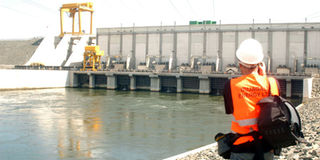Uganda looks to increase use of thermal electricity

An official takes a picture of the Bujagali Hydro Power Station. It is estimated that the contribution of big hydro stations will reduce from 78 per cent to 68 per cent over the next three years. FILE PHOTO
Kampala.
The use of thermal electricity in the national power grid will increase from 4 per cent now to 16 per cent by 2016.
This comes against a backdrop of the slow pace of the construction and commissioning of renewable energy power plants.
Mr Eriasi Kiyemba, the chief executive officer of the Uganda Electricity Transmission Company Limited (UETCL), said the increase is to stave off load shedding.
“You have heard about when they expect to commission the new hydro power plants, 2016. By that time we will have depleted the existing big hydros. That is why we factor in the thermals,” Mr Kiyemba told Daily Monitor during an interview in Kampala.
He acknowledged that the tariff for thermal electricity is currently higher than that of hydro.
But electricity users should know that they would spend more – on diesel – if there were to be loadshedding, he said.
Uganda currently has two thermal electricity plants, Jacobsen and Electromaxx.
Each has an installed capacity of 50MegaWatts (MW).
However, due to the cost of electricity, which ranges from $25.28 (Shs692.25) to $27.08 (Shs747.63) compared with Bujagali Energy Limited’s $12 (Shs332) per unit, the government buys only 7MW from each of the two thermal plants.
Still, Jacobsen has applied for a license to establish a 100MW thermal power plant in Hoima District next year.
The Hoima plant is likely to be commissioned in 2016, one year before the start of the commercial production of Uganda’s own crude oil.
And because the plants will use Uganda’s crude oil – some government officials have, separately, argued – the cost of thermal electricity is likely to reduce from the current level.
Future projections
According to Uganda Electricity Transmission Company Limited’s 2014–2016 projections, the contribution of large hydros will reduce from 78 per cent to 63 per cent over the next three years.




